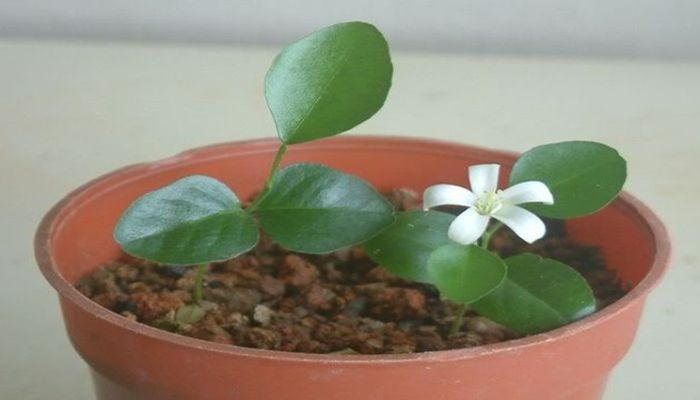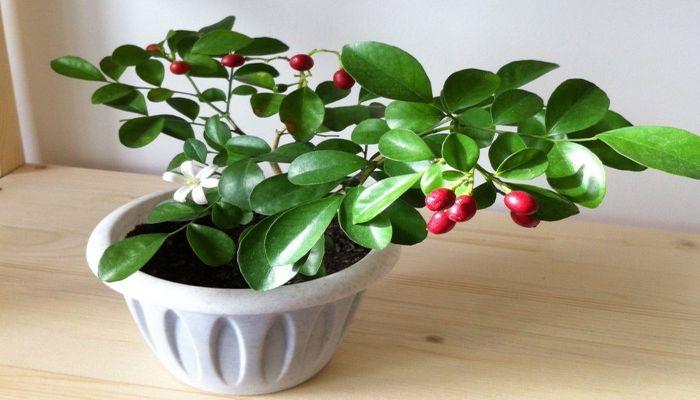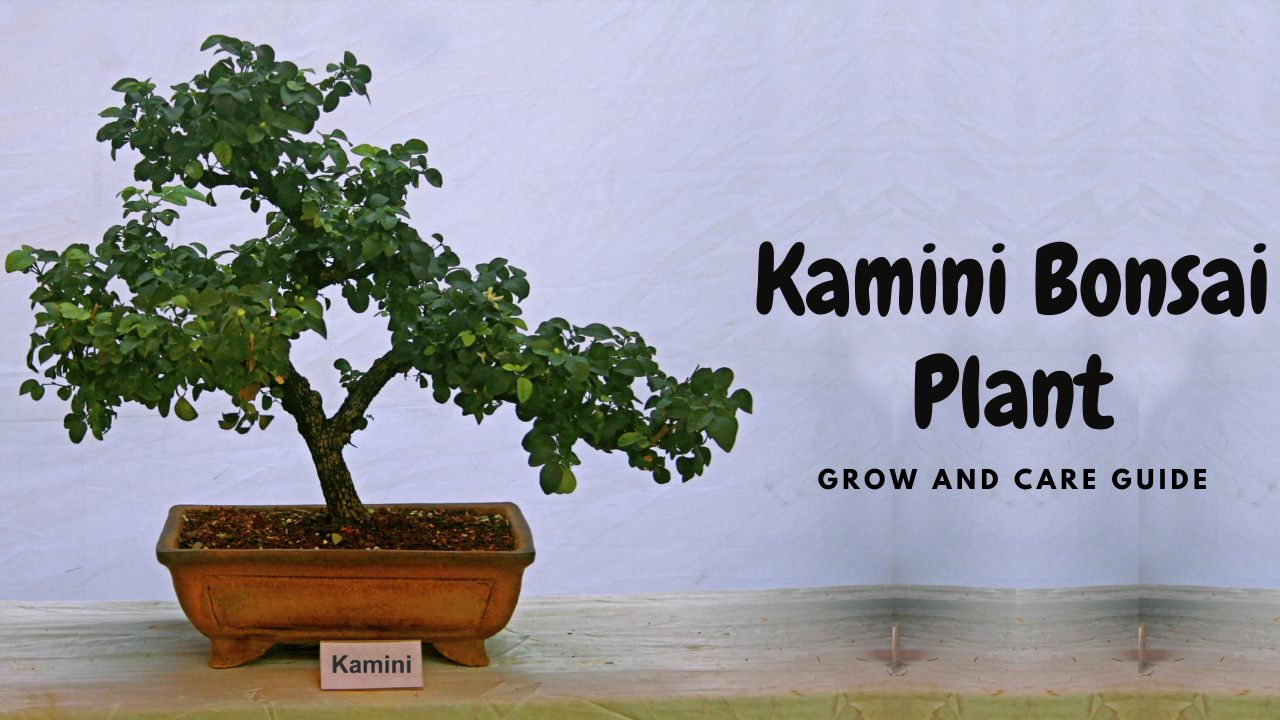Learn in this article How to grow and care for Kamini bonsai (orange jasmine).
Do you know that this plant is native to India and has many varieties?
It is also known as orange jasmine, Chinese box, and Murraya plant (Murraya paniculata).
The plant is a very beautiful tropical flowering plant. It blooms flowers that are sweet, sour aromatic, small in size, and blooms throughout the year.
Moreover, most people use this plant as a hedge or ornamental plant. With good care, this plant can be grown in a small container.
So, Let’s dive deep to understand the Kamini plant with its growing and basic care needs.
Popular names in India

| Orange Jasmine, Chinese box, Mock orange, Honeybush, Kamini | Hindi |
| Kunti | Marathi |
| Maramulla | Malayalam |
| Kamini Phool | Nepali |
| Nagagolungu | Telugu |
Indoor bonsai plants are a wonderful way to bring a touch of nature into your home or office. These miniature trees offer many benefits, such as improving air quality and reducing stress. With proper care and attention, indoor bonsai plants can thrive for years, adding beauty and serenity to your space. There are many species of indoor bonsai plants available, so do some research to find the one that suits your needs best.
Kamini Bonsai Plant specification
| Botanical name | Murraya paniculata |
| Family | Rutaceae |
| Common name | Orange jasmine, Chinese box, Kamini plant |
| Height | 3-7m |
| Leaf Color | Green |
| Flower color | White, red, and pink |
| Light | Full or partial sun |
| Water | Frequent, when 2-3 inches of topsoil gets dry |
| Fertilizer | Organic Fertilizer |
| Temperature | 15-30 degrees Celsius |
| Climate | Tropical, subtropical |
| Soil | Alkaline, clay, sandy, acidic, and humid soil. |
| Pest | Ants, scales, whiteflies, nematodes. |
| Advantage | Easy to grow |
How to Grow Kamini Bonsai Plant from the seeds

It is easy to grow the Kamini plant from seeds as it is the most reliable method because the plant does not respond well to the asexual promotional method like cutting.
Follow the below steps to grow the Kamini plant by seed.
- Wait for the orange jasmine (Kamini plant) fruit to get ripened; when the fruit becomes bright red, peel the outer coat with a sharp knife and get the yellow-white seed out.
- Wash the seeds properly in cold, clean water, so that sticky flesh is removed completely.
- Dry the seeds for 15-20 minutes before sowing them. Prepare the pot and check its drainage hole.
- Fill 3- inches of the pot with a potting mix and a part of the perlite mixture. Press the mixture so that there are no air pockets at the bottom of the pot.
- Sow the seeds in a pot and cover them with loose soil.
- Set the pot on the germination mat, where it can get bright, indirect light. For germination, the ideal temperature is between 75 to 80 degrees Fahrenheit.
- For enough moisture, cover the pot with plastic sheets.
- Check the moisture level of potting mix regularly as it dries fast. Whenever it dries more than ½ inch, add water. You can use a spray bottle for watering.
- It takes about 1 month for germination; sometimes, seeds may take two months.
- Remove the plastic sheet and place the pot in the outdoor area to get bright and indirect light.
- Fill an 8-inch pot with sterile potting mix and plant the Kamini; face the plant to direct sun after a week.
How to Care for Kamini Bonsai Plant

Location
Place the plant where it can get full sun, although it can beat partial shade. But a sunny window is the ideal place for the Kamini plant.
Temperature and humidity
The Kamini Plant is a tropical plant, and it thrives well in hot and high temperatures. The minimum temperature at which this plant survive is more than 40 degrees Fahrenheit. Also, it prefers high humidity.
The Kamini plant cannot survive in too cold temperatures, heavy frost, and snow.
Sunlight
Kamini bonsai prefers hot climates and direct sunlight. However, it also grows well in partly shaded sunlight.
Please do not keep the Kamini bonsai close to the glass window, as it intensifies the sun’s rays and burns the leaves. Too much direct sunlight burns the leaves of the plant.
Soil
Kamini plant needs the following properties in its soil
- well-draining soil
- rich soil
- Slightly moist at all times
Garden Soil + Coco Peat + Organic Compost will be the perfect mix for the Kamini plant.
The plant thrives well in alkaline, sandy, acidic, and humid soil. The soil should be good in moisture, not damp or soggy. Well-draining soil will keep your plant healthy.
Propagation
Cuttings or seeds can propagate the Kamini plant, but it is easy to develop it by stem-tip cutting.
- Cut a 5-6-inch-long stem of the Kamini Plant
- Cutaway the leaves at the bottom of the cutting.
- Now, place the cutting in water.
- When roots develop, transfer the plant into a new pot and add fresh soil.
Tips:
- Dipping the Kamini bonsai tree cuttings in rooting hormone always gives the needed boost for root formation.
- When taking the cuttings, aim to cut just below where the leaves of the plant attach to the node. This position has proven to produce perfect roots. If you leave a section below the stem, it will eventually rot.
- If any Kamini flower has existed in the cutting, it’s better to remove it before going on the rooting process. First of all, flowers will try to consume the nutrients that exist in the cutting to produce seeds, which could have been helpful in root production. On the other hand, if the existing flower doesn’t get enough nutrients (that is mainly possible) it will rot and create mold, a diseased cutting won’t give good results even if you dip them in rooting hormone.
Watering
During summer Kamini bonsai plant needs frequent watering as it is kept under full sun. Water the plant when one inch of the topsoil is completely dry.
The frequency of watering depends on the intensity of the sun and humidity. More watering is needed if the climate is hot and dry, as the topsoil gets dry in just 1-2 days. The soil gets dry in 5-7 days during winter, so water it once a week.
Do not underwater the Kamini plant, as it will immediately start to burn the leaves.
Fertilizing
Feed the plant once every 3-to 4 weeks during the growing season. Use organic fertilizer of about 200gms.
For flowering, Phosphorus and potassium are needed. Apply some DAP (Di-ammonium Phosphate) 1 tsp and ½ tsp potassium.
Pruning
After the flowers have fallen off, do the light pruning. You can do light pruning in February month, just before the growing season, so that new branches can develop with flowers.
You can also prune when the bonsai has multiple flowers growing along the stems, but you need to perform selective pruning. You can only cut below the spent flower, it will help to create budding further down the stems. If the branch has a single flower, you can prune the branch altogether, cause there’s a high possibility that it will not give another flower.
Pruning the Kamini bonsai plant will encourage flower production. Basically, pruning opens up the canopy and allows sunlight to penetrate the parts, which stimulates flower formation.
Repotting
In a small pot, the Kamini plant easily becomes root-bound and has to be repotted. While repotting, the roots may need light pruning.
To decide what pot can pair up with what tree relying on the root system of the tree itself. When you are repotting the Kamini plant for bonsai, be it the root or the upper part of the tree, all dimensions will be under your control. So, take as kamini bonsai tree has a root-bound habit you need to choose a pot that will have enough space and make a good display, no matter what you do don’t choose one that will suffocate the entire root system.
If your plant is presently in a plastic pot, squeeze the sides of the container to lose the soil and take the tree out. If it’s in a sturdy pot, keep it sideways from the base, wiggle the tree, and take it out. If that doesn’t work, drench the soil with water for about thirty minutes and take it out.
- Start by raking out the soil with a root rake from the roots. Untangle the roots, if any. Now they are ready to prune. Remove unruly roots and the roots that have extra growth.
- In the chosen pot, use a layer of water-draining pebbles, and a layer of bonsai potting mix, and plant the tree. Cover the roots with more soil, but make sure the majority of the trunk is outside the soil surface.
- After re-potting, water the plant religiously.
- Mature trees can be re-potted every after 4-5 years.
If you are new to repotting, don’t worry, we have a whole article with the repotting process in detail.
Pests
Some insects such as soil nematodes, scales, whiteflies, and suti molds are the problem, and they appear in the soil around the plant. Besides, nematodes can be beneficial or harmful to the garden, but they attack other plants and spread the virus.
Scales suck the plants, which leads to a lack of necessary nutrients in the plant. You may spot black fungus sometimes on the leaves, and this fungus blocks the sun’s light on the leaves.
Additionally, the fragrant flowers of the Kamini plant drip sweet liquid, which attracts ants. You can spray neem oil around the plant base to get rid of this problem.
Usage of Kamini Plant

- The Kamini plant is used to kill traditional medical analgesics.
- Its wood is used for making handle tools.
- In western countries, it is used as a decorative tree.
- Kamini plants are often planted near honey bee ranches to serve as the food source for the honey bees to protect them from harsh winds.
- Honey bee nectar gathered from honey hives that gather pollen from Kamini flowers has a tart-sweet orange flavour.
- Due to its solidness and wide scope of soil resilience, it is used for decorative purposes and is appropriate for bigger hedges.
- Moreover, the plant blossoms consistently and creates little, fragrant flowers in bunches that draw honeybees, while its fruits attract little frugivorous birds.
Kamini Plant varieties
There are many varieties of this plant, such as it can be a luxurious houseplant. But its most popular species is polyethylene, which has fragrant and pink flowers. Apart from this, many other varieties of Kamini plants, including primrose jasmine and common jasmine.
FAQs
1. Is Kamini bonsai an indoor plant?
Keeping the plant indoors in moderately bright light is advisable as it thrives best in that environment. Good air circulation and ventilation enhance its development.
2. What is the best fertilizer for the Kamini bonsai plant?
The best fertilizers to use for the Kamini plant are NPK fertilizers and organic humus-rich fertilizers.
3. How can I make the Kamini plant grow faster?
Plant the Kamini bonsai in full sun to partial shade. Give the plant the proper water and fertilizer it needs. The proper amount of water will ensure that your Kamini plant grows optimally.
4. How long does it take Kamini plant cuttings to root?
Generally, it takes 3-4 weeks, but some plants may take longer to root. When the roots grow 1-2 inches long, the cutting is ready to be potted.
Conclusion
Kamini bonsai is advisable to keep the plant inside in moderately bright light because it thrives best in such an environment. Moreover, good air circulation and ventilation around the plant will enhance its development.
However, too much direct sun will burn its leaves, causing them to turn brown. For the healthy growth of Kamini bonsai, get rid of damaged or dead leaves.
If your plant is more than two years old, you can fertilize it with an all-purpose fertilizer. The best time to fertilize this plant is in spring, as new foliage is about to grow.
You can do pruning in the winter season to attain the desired size and shape. And repotting should be done once the roots begin to outgrow the pot.
Purchase this beautiful Kamini plant online at the best price to add beauty to your place.
Related Articles
- Propagating Chinese Elm Bonsai Cuttings And From Seeds
- Best Chinese Elm Bonsai Soil and Fertilizer.
- Troubleshooting Common Problems With Chinese Elm Bonsai
- Buy Chinese Elm Bonsai: How Not to Get Scammed When Purchasing a Chinese Elm Bonsai Tree!
- Chinese Elm Bonsai Pruning And Styling.
- Creating a Chinese Elm Bonsai Forest- Step-By-Step Guide.


My Kamini bonsai plant is shredding leaves.
Some time the leaves become yellow and shred and sometimes it becomes brown and shred. It’s near the window and I water when the soil is dry.
Any suggestion how to stop my plant from shredding leaves?
My Kamini bonsai plant is shredding leaves.
Some time the leaves become yellow and shred and sometimes it becomes brown and shred. It’s near the window and I water when the soil is dry.
Any suggestion how to stop my plant from shredding leaves?